The Future of Retail Around Boston Is Better Than You Think
With the rise of Amazon and Wayfair, Boston shoppers are abandoning stores like mall rats from a sinking ship. Now, retail is fighting back—and selling you something you can’t get anywhere else.

Photo by Tim Kennedy
It’s an unusually chilly Sunday in September, the kind of weather that gets you thinking about the sweaters and jackets you shoved into the back of your closet on the first hot day in May. Maybe that’s a sign it’s time to go shopping. Down on buzzing Newbury Street, which on this particular day happens to be car-free, dozens of undergrads saunter into Lady M bakery for its signature French-inspired Mille Crêpe cakes. Baby boomers who’ve swapped their Weston Colonials for single-floor condos stand next to younger couples (as-yet childless, comfortable in their newly built two-bed Southie flats) while a Gen-Zer ululates his way through “Stairway to Heaven” like he’s just rescued the song from the $1 record bin of history. Though the sky threatens rain, a couple of bright-eyed parents of college students sip cocktails facing the street at local institution Sonsie. A few steps above it all, at FoMu, high school girls with nerd glasses and baggy sweaters salivate over the made-in-Watertown vegan ice cream on offer. At Lush, clusters of women in yogawear stick their noses into sample tubs of free-trade, cruelty-free Karma Kream, inhaling notes of ethically harvested orange and patchouli. All of which tells me that IRL shopping—the kind that forces you to show up, in a store, and hand over actual money to a human being—is far from dead.
At the same time, the disrupters of the retail world—a.k.a. online sellers—are doing anything they can to get us to click for our supper. They’re innovating at an intense rate, offering everything from voice ordering to real-time pricing in an attempt to entice us to buy. They’re also mining our social media habits, emails, and Alexa commands, seeking to influence what we do next on the Web—which, naturally, should be purchasing whatever thing we’ve been talking, texting, or even thinking about. In the increasingly creepy sophisticated online world, nothing is accidental.
But that hasn’t quite signaled the death knell of brick-and-mortar retail. Not by a long shot. Exuberant local leasing agents, shop owners, and developers say that stores here are alive and thriving. “The retail apocalypse is a myth,” says Bridget Beckeman, director of retail strategies for the Wilder Companies, which develops and manages large retail properties on the East Coast. All of those bankruptcy headlines? The JCPenneys, Sears, and Toys R Us of the world that are going, going, or gone? Sad. Really, very sad. It’s true that among their many faults, these retailers couldn’t adapt to the post-Amazon, post-recession world and have thus been culled from the herd. “The so-called retail apocalypse is just this prolonged flushing out of those who don’t belong anymore,” agrees JLL managing director Chris Angelone, who focuses on the sale of retail, mixed-use, and office properties in New England.
As for those that remain? They’re duking it out for highly solvent customers right here on the mean streets (and in the malls, and retail centers, and shopping experiences) of Greater Boston. Just as Columbus, Ohio, was once the test-market capital of the country due to its solidly Middle America status, Boston has become a major indicator for what wealthy, educated enclaves across the country demand from their retailers. Accordingly, sellers are offering every permutation of amenity and branding to hook Boston’s elite shoppers: Organic! Ethical! Online ordering with curbside pickup! Custom tailoring! In-store events! That’s innovation aplenty to keep local analysts busy. “Retail has to evolve,” says Sara Al-Tukhaim, a senior vice president at Kantar, a consulting firm that analyzes retail growth, “but it’s doing interesting things to reinforce its presence.”
As someone who often finds herself caught between online convenience and a moral commitment to brick-and-mortar, I knew that if I wanted to understand the future of retail in Boston and how it’s luring buyers away from the siren call of Amazon, I had to, well, go shopping. And I’m taking along a compatriot whose name also happens to be Rachel to see what it takes to get her to shell out some coin in a real, live store, too. The contenders vying for our money: the traditional mall, the new inside-out mall, and the classic (and not so classic) urban shopping landscape. So, Boston retailers, bring it on. Just try to make us part with our money.
I’m at a shoe shop watching a Danish-born artisan craft wooden clogs right before my eyes. No, I haven’t ditched Boston for Scandinavia—Rachel and I have just driven 16 miles north to Burlington Mall, where Scandic Footwear peddles locally made $230 clogs to fashionable thirty- and fortysomethings with money to burn and an appreciation for Old World shoemaking. A classic indoor shopping center opened in 1968, Burlington Mall occupies 1.3 million square feet owned and operated by mall giant Simon Property Group, which has been working hard to upgrade its properties with higher-end stores (see: Scandic) that appeal to well-to-do Americans. Urban critics, including the Globe’s Robert Campbell, a Pulitzer winner, typically pooh-pooh this type of mall, which they consider retrograde, stifling, and destructive to the fabric of whatever town it happens to occupy. Indeed, Burlington Mall probably sucked the life out of the small retailers that came before it, but that was long ago. Now it has problems of its own.
The shopping complex is currently in the process of rebranding after the loss of Sears earlier this year, a trend that’s repeated itself all over the country as the big-box stores that dominated the retail landscape for the better part of the 20th century continue to shutter. One of the big retailers’ fatal errors was adapting too slowly to the digital age. But in truth, their demise had just as much to do with the shifting of expendable income from the many to the few. You’ve heard about income inequality, but it’s worth repeating that over the past decade, the top 20 percent of Americans’ income grew 1,425 percent more than the lowest 40 percent’s, which means more dollars are held by fewer people. According to a 2018 Deloitte study, much of the lowest 80’s income will be increasingly consumed by ballooning healthcare debt, education debt, and food costs. Not exactly a reliable customer base for giant stores with giant footprints that strive to offer a veneer of decent service and varied merchandise. Sears is one of many chains that tried to appeal to everyone and, in so doing, has ended up fighting off bankruptcy.
Like so many other older shopping centers, Burlington Mall has had to figure out what to do with Sears’ enormous, empty husk of a building. Fortunately, there are precedents: Wherever you find concentrated wealth, from the ashes of big-box stores rise tony conversions. The former Sears in the Northshore Mall in Peabody may become an enormous Life Time Athletic club. In Santa Monica, California, a $60 million renovation will transform a shuttered Sears into high-end office spaces and an upscale food market. In secondary and tertiary markets, like the Susquehanna Valley Mall in central Pennsylvania, the Sears buildings are being converted into healthcare clinics. And at Burlington Mall, where a mixed-income hedge makes sense, the gutted Sears will become the permanent location for discount fast-fashion shop Primark above (where it first opened in 2016) and a slew of smaller restaurants and retailers on the first floor. “You need those experiential things to capture the customer and keep them at the property,” Simon Property Group vice president of development John Phipps told the Burlington Planning Board this summer.
So, how’s Burlington Mall doing? On that rainy Sunday, Rachel and I start in Macy’s, then venture into the main mall with its two-story atrium. Other than Scandic, though, 2018 upscale-retail trends haven’t quite caught on here. At the moment, it’s all the usual suspects: Eddie Bauer (well stocked, friendly service); Lands’ End (vast, empty, and sad); and, finally, the thumping yet dark and mysterious stage set of Hollister (vibrant with teens who wonder why two olds are bringing down their shopping experience). I walk around holding a $20 T-shirt, then ditch it after seeing the dressing-room line.
Back in my Subaru, we leave the ghosts of retail past in our tracks and head down 128 South, crossing the Mass. Pike and edging a little closer toward the future.
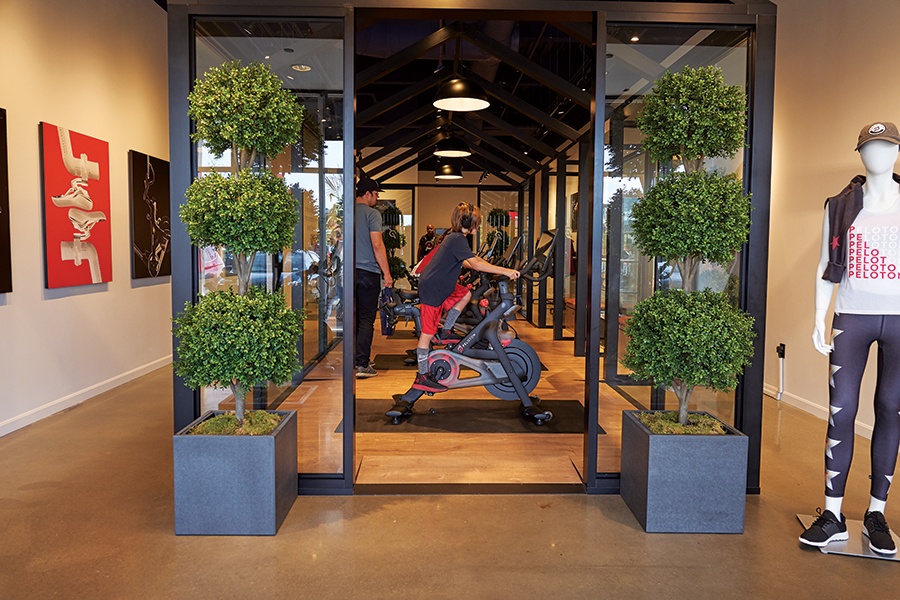
Photo by Tim Kennedy
Our first stop after parking the car at Legacy Place in Dedham is Peloton, the stationary-bike sensation taking over the world with the promise that you don’t actually have to go to the gym to take a spin class. At Peloton, you can buy what I have to assume is the planet’s most expensive stationary bike ($2,200), and for $39 per month (cheap!), get unlimited access to proprietary virtual classes. The bike comes with a big LCD screen, so you can pedal along to Peloton’s live and prerecorded instructors anytime you want. Could you watch something else on that screen, like Jurassic Park or your cousin’s old wedding video? Non. In search of an experience—the buzzword today in retail circles—I put down my bag, enter the Peloton exercise corral, and try out a bike. Very smooth. As the saleswoman explains the system’s many virtues, I mentally carve out space for this hunk of metal in my 1,100-square-foot apartment.
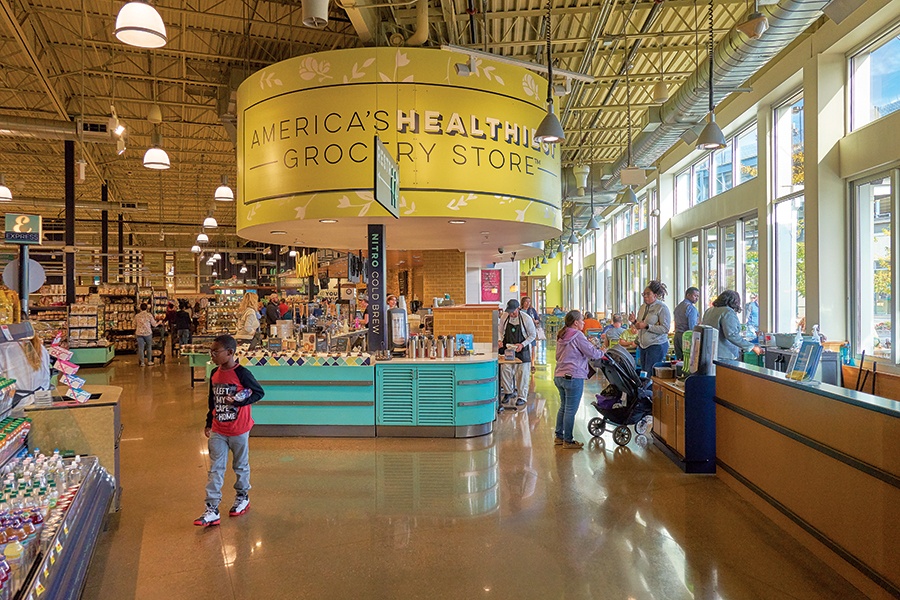
Photo by Tim Kennedy
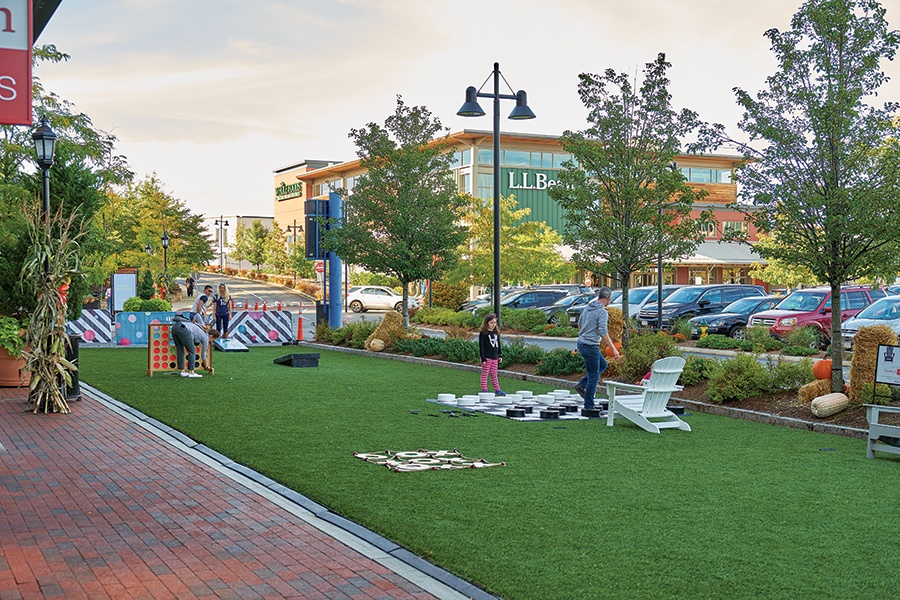
Photo by Tim Kennedy
Peloton is just one of 80-plus shops, restaurants, and service providers that make up Legacy Place, a prime example of the first wave of suburban shopping centers built after the Great Recession. Developed by locally based WS Development and designed by Prellwitz Chilinski in 2009, the concept for this “lifestyle destination” is known in the retail biz as an inside-out mall or open-air community, meaning entrances to the shops swing out to the street, the air, the rain, all the real things that fusty old traditional malls shut out (see also: the Street in Chestnut Hill, MarketStreet in Lynnfield, and the Derby Street Shops in Hingham, also WS properties). Notably, they are anchored by a grocery store, in this case, Whole Foods. In this new retail world, one-story stores surround two large and lovely asphalt quads gleaming with parked cars. A multistory garage along one side of the complex offers reassurance that unlike on Newbury Street, you will, in fact, be able to park.
Legacy Place’s completion nine years ago prompted a review in the Globe by Campbell, who essentially said, fine, if wealthy suburbanites want a completely contrived town center engineered around driving convenience, here it is. His most incisive gripe was that unlike the traditional Main Street, Legacy Place fails to offer any standard services, such as a shoe-repair spot, a tailor, or a hardware store. Poor Campbell—he still thinks people want to fix things.
True enough, you can’t resole your shoes at Legacy Place or pick up a bag of screws, but you can reinvent your body at Pure Barre and SoulCycle—exactly the kind of personal services that retail experts extol. “There’s now an expectation of high-quality experience, unique merchandise, or significant value,” Angelone says. Specialty gyms are considered a draw—they guarantee regular foot traffic and will never be replaced by the Internet. (Even if Peloton begs to differ.)
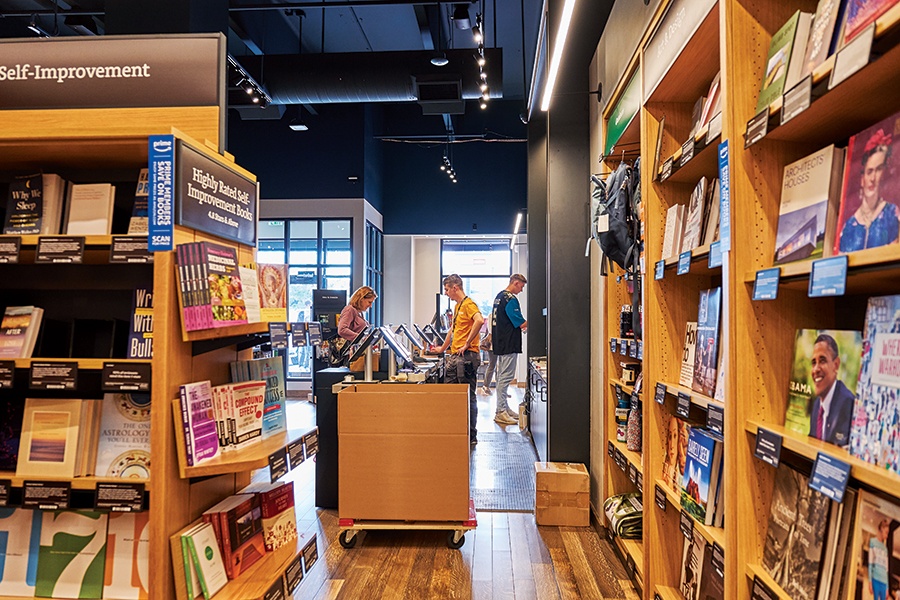
Photo by Tim Kennedy
Peloton, as it turns out, is just one in a sea of online startups with major private equity backing that want a piece of the brick-and-mortar magic, including menswear retailer Bonobos, eyeglasses maker Warby Parker, and, yes, Amazon. Why would an online-only empire want to cut into its bottom line by engaging in the highly inefficient, messy real estate market? After all, leasing commercial space is pricey and risky; hiring and training staff, especially in expensive markets like Boston, is a constant headache; and in many cases, because these shops have little (or no) stock, thereby delaying customer gratification, they lose sales. But these clicks-to-bricks outlets, as they’re known, have very different goals from the traditional store: The retailers want you to see them whenever you shop, to remind you that they exist. It’s real estate as billboard. Salespeople are considered brand ambassadors. And then there’s the invaluable data these stores generate about their customers’ habits and preferences. When you show up in person, retailers really, really find out who you are and how you think.
I’d never been to Legacy Place before today, but Rachel, who regularly travels here from her Brookline home for the Showcase Cinema de Lux multiplex, explains the draw to me: It’s familiar yet new; it’s safe. When they’re shopping, many wealthy suburbanites don’t want to deal with the messiness of the city, with its broken sidewalks and ticking parking meters. They like to be able to hand their kids a $20 bill for ice cream down the “street” while they sip the last of their overpriced glass of Syrah in peace. That’s the promise of the inside-out mall. It’s a private village, a shopper’s and eater’s paradise patrolled 24/7 and regulated by the rules of developers who understand their customers’ needs implicitly.
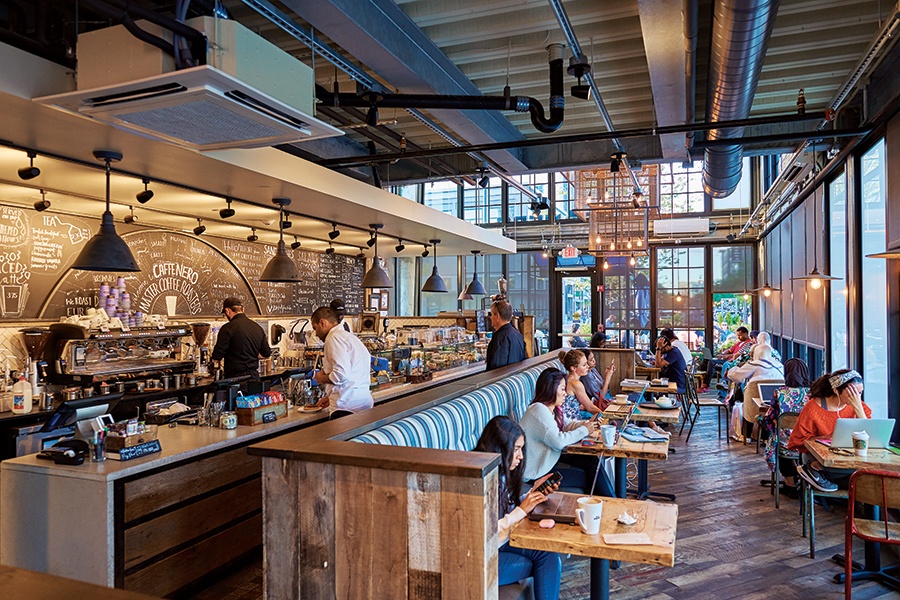
Photo by Tim Kennedy
Admiring the sea of parked cars (that is the view, after all) to a soundtrack of piped-in music on outdoor speakers, my safety isn’t in question, but my willingness to pull out my wallet is. Few people are around; the place feels lethargic. We finally settle on a cup of coffee at Caffè Nero. If you’ve been to any Nero, you know what we saw: a fully realized book-themed stage set, complete with shelves up to the ceiling lined with decommissioned library tomes. I peruse a few obscure volumes. Everyone else is looking at their phones.
It’s easy to make IRL shopping appealing in the ’burbs, where you have a captive audience and room for companies to build fancy corporate stores with, yes, plenty of parking. But how do urban retail developers, restricted by smaller footprints and high development costs, appeal to a savvier city-based clientele?

Photo by Tim Kennedy

Photo by Tim Kennedy
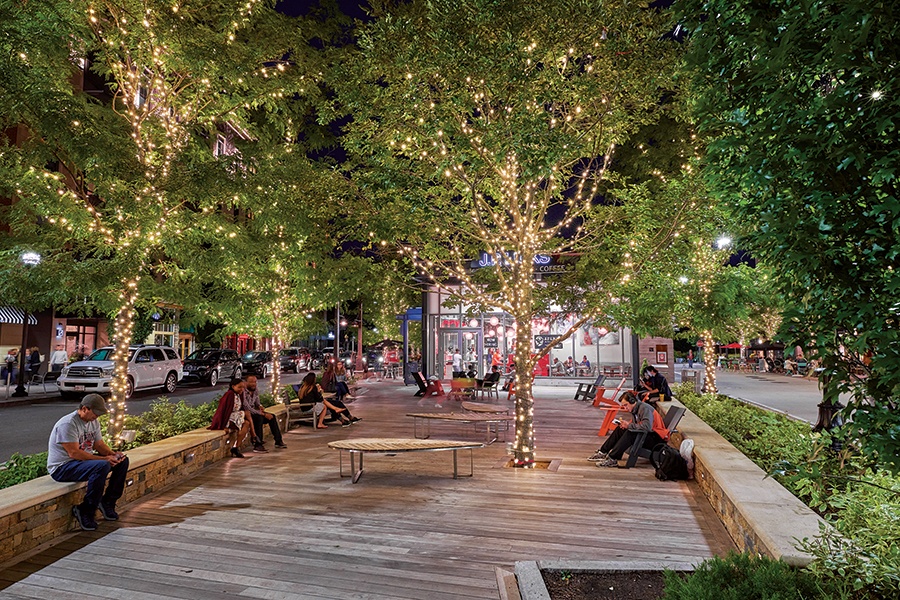
Photo by Tim Kennedy
These days, leasing and development experts—all of them—talk about experience. “[We’re looking for] tenants offering more than just transactional functions,” says the Wilder Companies’ Beckeman. It’s that little extra something-something that transforms the mundane exchange of currency for goods and services into a magical event. Al-Tukhaim points to Roche Bros. grocery store, which is becoming like a café; the Walgreens flagship downtown that’s focusing on health and wellness with its sushi and juice bar; the urban-sized Target in the Fenway, which is squeezing big-box retail convenience into smaller spaces; and Eataly, which she calls the Disneyland for food.
That’s on my mind as Rachel and I pull off the highway into Somerville’s Assembly Row, a once forlorn brownfield that’s now a retail “destination neighborhood.” The concept behind the design was driven by the idea that Assembly Row could become an extension of the city fabric, and I am heartened by the thought that this dense, mid-rise neighborhood could be expanded as needed. Assembly Row was developed by Maryland-based Federal Realty, which worked hand in hand with Somerville leadership to create a hopping mixed-use village—complete with apartment buildings, offices, five boutique gyms, easy access to the T, and plenty of unique restaurants—all on the banks of the Mystic River. As I stroll the narrow shopping streets, I find myself enraptured by the energy. The scale feels right. The place is busy. People live and work here. I want to throw dollars out the window!
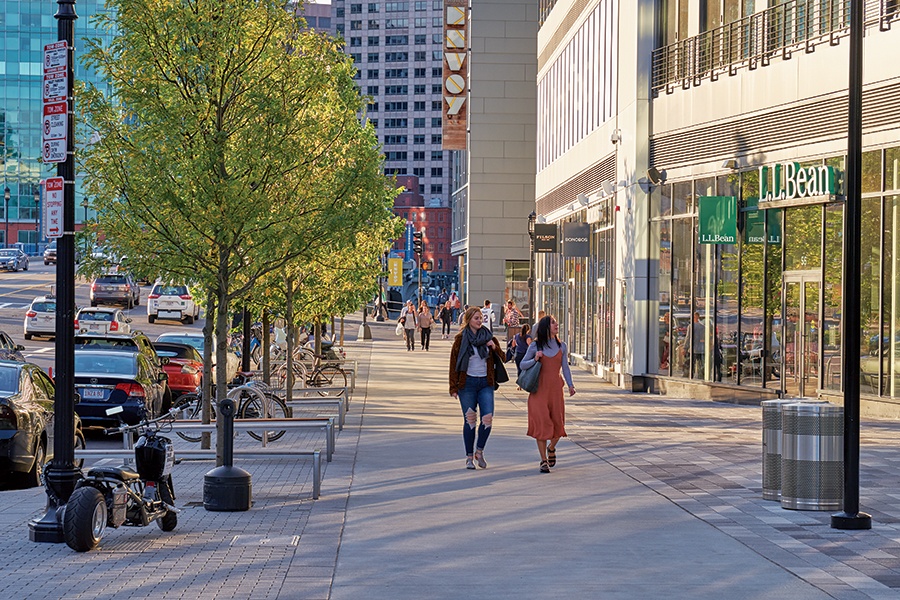
Photo by Tim Kennedy
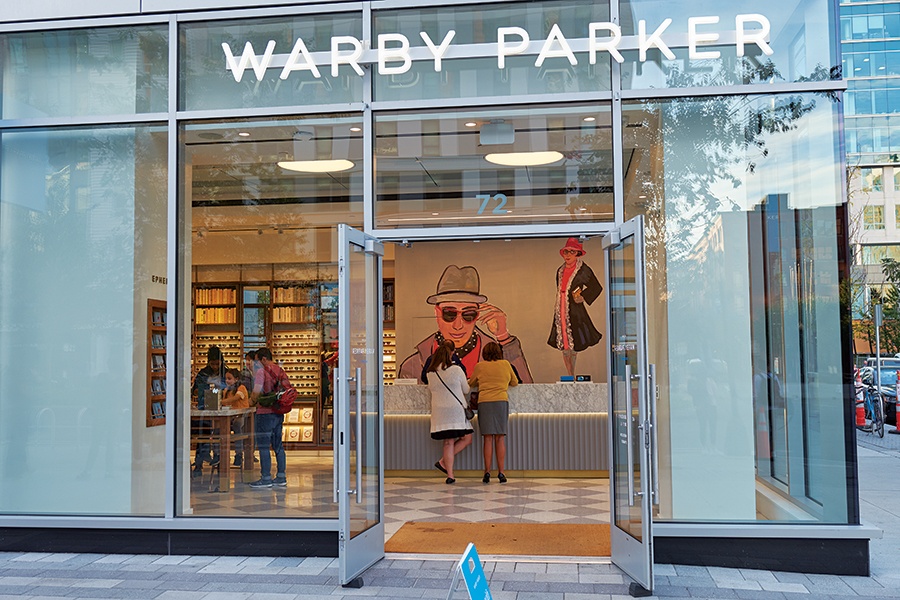
Photo by Tim Kennedy
Over in the Seaport, WS Development is attempting to score a similar triumph. To be honest, I’ll probably never be able to recover from the piss-poor planning that resulted in enormous super-blocks of ultra-expensive condos and characterless office buildings ruining what could have been a tremendous waterfront experience for all Bostonians. Don’t hold this sordid history against WS and the other developers down there, I suppose. The blossoming mix of retail here includes the requisite movie theater, a Kings bowling alley, a huge Equinox gym, and plenty of homegrown dining options. There’s also a healthy mix of unexpected, exclusive-to-the-Seaport stores, including Mr. Sid (a high-end menswear shop based in Newton), as well as clicks-to-bricks retailers such as Bluemercury (cosmetics) and Blank Label (more menswear, but made to order).
In truth, however, the supreme model for all of these fabricated urban streets is old, fabulous, irreplaceable Newbury Street, which, on this particular Sunday, is car-free. Without vehicles parked on both sides and the two (!) lanes of westbound traffic, I can appreciate how wide this street is and how much civic potential it has. Despite the cloudy, chilly weather, the 1-mile stretch of retail goodness has attracted thousands of people.
It’s at Muji, the only New England outlet of the Japanese-based “basics” chain that completely nails the lush shopping experience, where I finally cave. Packed with shoppers of every age and ethnicity, the store is infused with the aroma of lemongrass and citrus scents emanating from proprietary diffusers. In the middle of the din, several people are lounging in the beanbag playground next to the long line snaking from the cash registers; others are exploring Muji’s custom embroidery options. There’s so much to stick your nose into, experiment with, read, write with, and try on that everyone seems engaged—including me. I happily shell out $175 for organic cotton sheets and a duvet cover. Three weeks later, they’re still in the bag, but I don’t regret it.
Back on the street bordered by brownstones and storefronts of every size and shape, I know I could only be in one place. Dearest Boston, do not forget that Newbury is your greatest retail asset.
For all of the talk of inside-out malls and destination neighborhoods and Newbury Street fairs, there’s little doubt that the e-commerce apocalypse is coming, and Boston’s retail developers would be foolish to simply cross their fingers and hope customers just keep showing up as always. That means they’re spending big bucks on market research and building a muscular leasing team to ensure that the mix of stores in any given shopping environment is just right.
Beckeman, for example, is currently “curating” Wilder’s newest development, Arsenal Yards in Watertown—a one-million-square-foot, mixed-use project that includes stores, offices, a hotel, a grocery store, a movie theater, and 425 apartments—and carefully calibrating it to be Internet-proof. “It’s about turning spaces into gathering spaces,” explains Beckeman, who previously worked for the company that leases out Chelsea Market in New York City, a runaway success that boasts impressive foot traffic, unique food offerings, and an exciting artisans’ market. “Developers are going to be spending a lot more money to create civic spaces.” To insulate the project from the forces of Amazon, her team has targeted 30 percent of the square footage for food offerings, some provided by top local restaurateurs. That means proactively courting chef-owners before they even think about opening a new place someplace else. Beckeman’s also targeting boutique fitness concepts such as Orangetheory and Btone, which “get people hooked,” stimulating a steady stream of foot traffic. Providers of personal services such as manicures and blowouts will never be replaced by the Internet, so she’s wooing them, too. Apparel, always a tricky category, is being carefully vetted and selected to match the area’s demographics. “A key differentiator between landlords that are successful is the right mix,” she says.
Beckeman explains that this push for smaller, more-local retail is possible thanks to new leasing structures that allow developers to take more tenant risks, which opens the door for new vendors with little in the way of credit muscle. That’s how Steve Samuels was able to pack the Fenway with homegrown venues including Tasty Burger, Sweet Cheeks, and Blackbird Doughnuts. In these leasing arrangements, tenants pay a lower base rent, then over time determine what’s called a natural breakpoint—a dollar amount in gross sales, above which the landlord receives an agreed-upon percentage. “Real estate developers are becoming incubators,” says Karen O’Malley, a real estate attorney with Goulston & Storrs, citing Hojoko, Tim and Nancy Cushman’s trendy izakaya in the Fenway.
Curating a new development like Arsenal Yards, Beckeman has a lot of leasing freedom. Her team must think not just about the retail mix, but about how people will get around in the future, including self-driving cars, Lyft, and Uber. “Things are changing so fast and you’re not always going to get it right,” Beckeman says, “but we’re focused on creating vibrant environments.”
All of this effort is in service to drawing big bucks from the upper 20 percent—those hardworking white-collar folks who hold so much of Greater Boston’s wealth. In truth, it’s well worth the investment, because this demographic is demanding. These shoppers will, without a second thought, walk through your store, fondle your goods, even try things on, and then step outside and comparison-shop online for a better deal, no question. Can you blame them? That’s why the brick-and-mortar game has higher stakes than ever, but it’s also why it offers some of the greatest rewards. Get it right, and brands will win loyal, deep-pocketed customers who seek you out anywhere; get it wrong, and, well, there’s always Amazon.


